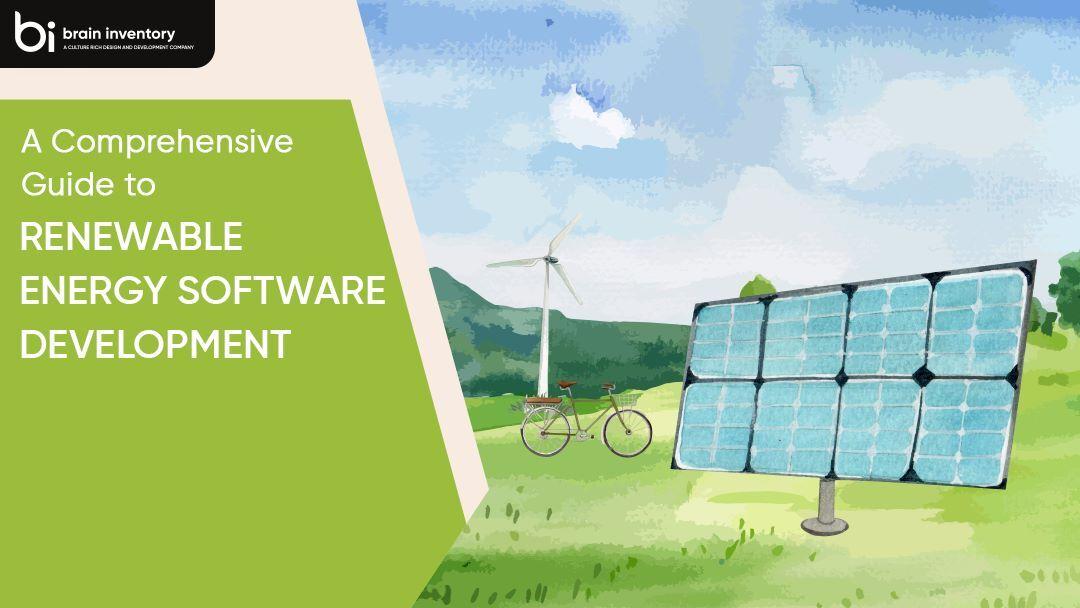A Comprehensive Guide to Renewable Energy Software Development

Quick Summary: In today’s fast-paced world, innovations are constantly blooming in different industries. The global shift towards sustainable practices has fueled the demand for innovative solutions in the renewable energy sector. One of the pivotal aspects driving this transformation is the development of specialized software tailored to the unique needs of renewable energy companies. In this comprehensive guide, we will explore why initiating renewable energy software development is a strategic move, uncovering opportunities across various sectors, and providing essential tips for successful implementation.
Why Start Building Renewable Energy Software?
Customized software tailored to the specific needs of renewable energy companies can address the challenges and problems faced by consumers, corporations, cities, and governments as they make the transition to clean energy. The software on this list addresses specific pain points in industries specializing in wind, solar, hydroelectric, and other forms of renewable energy.
Optimized Resource Management
The wave of popularity for renewable energy sources has prompted the creation of many software tools specialized in renewable resources management and control. The collection of these tools is commonly referred to as Renewable Resource Software (RRS). These programs allow precise scheduling and tracking of renewable energy generation and its environmental impacts, which are measured on a real-time or scheduled basis.
Data Analysis and Insights
Renewable energy production has been growing exponentially in the past decade and will continue to increase rapidly in the coming years. The key to this explosive growth is data. Data on solar irradiation, weather conditions, production capacity, local energy prices, electricity transmission costs, and numerous other factors are required for assessing potential sites for renewable energy systems.
Integration with Smart Technologies
Renewable energy software is the solution that can help you optimize your energy-producing facilities and reduce costs. Renewable energy software is useful in integrating with smart technologies allowing automation, monitoring, and controlling of energy systems to deliver on-demand power when, where, and at the cost the utility desires.
Opportunities for Renewable Energy Companies
Renewable energy software opens up a myriad of opportunities for companies operating in the sector. These include tracking your progress, managing job vacancies, and reducing errors to name just three. It’s not surprising that many businesses are asking how renewable energy software can help their business.
Enhanced Project Management
Planning software helps in the effective planning of large-scale renewable energy projects. It facilitates effective tracking and measurement of various parameters related to a project. It provides collaborative tools that enable the distributed teams involved in the project to effectively work together.
Predictive Maintenance
Predictive maintenance is the practice of using software for machinery and equipment to track usage and make corrections before serious failures occur. Benefits are threefold: increased uptime with a reduction of downtime, improved efficiency and safety, and lower costs due to fewer breakdowns. The information generated by the software helps to identify what requires improvement by examining real usage behaviors. Predictive upkeep assists companies in maximizing the value of their resources without the danger of paying for avoidable malfunctions, which can become expensive as time passes.
Grid Management and Optimization
For utilities, smart grid systems can boost the performance of grid components with the use of modern information technologies. Intelligently integrated, these energy management solutions can turn your entire electrical infrastructure into a real-time data collecting asset for efficient power distribution and supply scheduling. Smart grid management software has also become an integral part of environmentally friendly strategies. With the help of this cutting-edge technology, you can efficiently invest in renewable energy sources while still ensuring the stability of your existing power grid.
Renewable Energy Software Development for Different Sectors
Customized software can be tailored to meet the various unique needs of different companies within the renewable energy industry. Every business is unique, with its own specific requirements and protocols. Having a custom software solution can bring process improvements, increased agility, efficiencies, and overall cost savings for both the company and its customers.
Solar Energy
Solar energy monitoring programs have been receiving increased focus lately. A growing number of businesses are transitioning to solar power. This change comes from the plentiful supply of clean, sustainable energy that solar provides, along with the progressively more appealing federal income tax deduction for home and commercial solar energy users.
Wind Energy
Wind farm management software is an increasingly important tool for the modern wind turbine owner. The increase in the construction of wind farms across the globe has led to a jump in costs relating to the operation and maintenance of these facilities. As more and more companies enter the business of generating energy from various sources, the need for efficient and cost-effective management systems will become vital to their success.
Hydropower
Many sectors demand software solutions for hydropower. The utilities sector is one of them. A modern electrical utility grid demands a reliable water availability to ensure continuous energy output. This is why the industry has created specialized software modules for water flow management, dam monitoring, and energy optimization.
5 Tips for Developing Renewable Energy Software
Understand Industry Requirements
Thoroughly grasp the unique requirements and challenges of the renewable energy sector to tailor software solutions effectively.
Scalability
Scalability is one of the most important factors to consider when designing software for renewable energy. The design needs to be capable of adapting as the size and complexity of a project grows so that your team can continue to function efficiently, maximizing your returns.
Cybersecurity Measures
As renewable energy systems become increasingly interconnected, they also become more vulnerable to a wide range of malicious cyberattacks. These attacks could include everything from the theft of large amounts of data to the destruction of energy sources. Cybersecurity has been on the minds of many people in the renewable energy industry for some time, but now it is becoming even more important as security researchers begin to identify ways that renewable energy systems can be made vulnerable to cyberattacks.
User-Friendly Interfaces
User interface (UI) testing is a method used in software development to check that the user interface of a system is reasonably easy to use and intuitive. This is done by performing a number of tests, usually concentrating on various features of the system, making sure test cases that should fail under one circumstance do fail, and confirming test cases that should pass under another circumstance do pass. The goal is to verify the usability of the user interface by methodically testing different usage scenarios and validating the expected outcomes.
Regulatory Compliance
Stay abreast of regulatory requirements in the renewable energy sector and design software solutions that comply with industry standards.
Conclusion
Renewable energy development has reached a new height as private corporations have initiated the transformation towards sustainable, clean energy. The renewable energy revolution entails the widespread adoption of green technologies such as solar, wind, and wave energy for power generation, thus replacing traditional fossil fuel-based power sources over time. These alternative sources of energy could be harnessed through smart renewable energy software solutions that produce significant reductions in carbon dioxide emissions. The software systems that directly address this revolution are largely categorized into four distinct sub-domains : (1) Energy management software, (2) Inventory software, (3) Security and monitoring software, and (4) Reporting and analysis software.
Brain Inventory are technologists in the clean energy sector. We provide reliable, high-quality software development and consultancy to our customers from across the globe. We are dedicated to realizing our client’s digital transformation needs by helping them build software solutions that can become competitive and lasting advantages for their organizations.

Have an idea?
Get in touch, we’d be
happy to hear from you
We are always looking out for new collaborations, whether you are a client who is passionate about a project or a talent who is interested in joining our team, our doors are always open.
locate us

India (HQ)
618, Shekhar Central, Palasia Square, A.B Road, Indore, Madhya Pradesh, 452001
+918109561401

United Kingdom
Brain Inventory, SBVS, 8 Roundhay Road, Leeds, UK, LS7 1AB
+18008209286

Canada
44 Main Street East Milton, ONCanada L9T 1N3
+4166696505

Jordan
185 Wasfi Al-Tal Street, Ammon Oasis Complex P.O Box 4724 Amman 11953 Jordan
+960770781000

USA
720 Seneca St Ste 107 Seattle, USA 98101
+1(206)6533419
if it's digital,we'll make it.
- Numetric - Online Accounting Software similar to QuickBooks
- Bloomia - Kegel exercise
- Virifi - Blockchain Powered Document Certification & Signing Platform
- Revolution Travel CRM - Custom CRM Built for Travel Agents
- Fatoura - Online Invoicing Platform
- My Fit Mantra - Your health partner
- Ocureel - Relation Building and video sharing Application